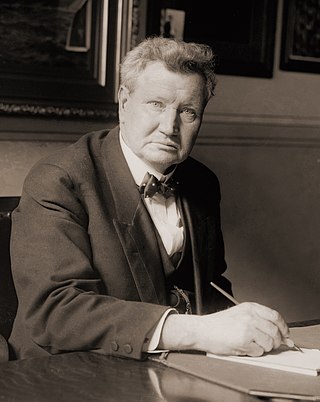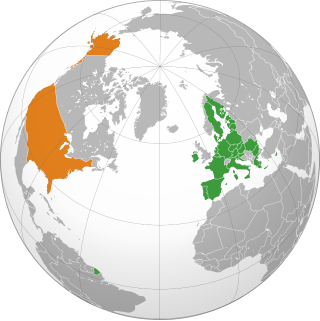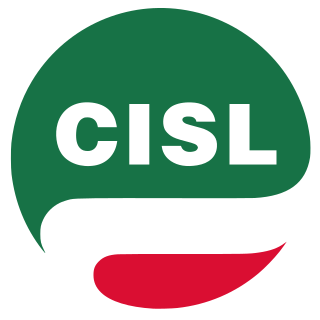
Nicaragua is a presidential republic, in which the President of Nicaragua is both head of state and head of government, and there is a multi-party system. Executive power is exercised by the government. Legislative power is vested in both the government and the National Assembly. The judiciary is independent of the executive and the legislature.

The World Federation of Trade Unions (WFTU) is an international federation of trade unions established in 1945. Founded in the immediate aftermath of World War Two, the organization built on the pre-war legacy of the International Federation of Trade Unions as a single structure for trade unions world-wide, following the World Trade Union Conference in London, United Kingdom.

The Norwegian Confederation of Trade Unions is a national trade union center, decidedly the largest and probably the most influential umbrella organization of labour unions in Norway. The 21 national unions affiliated to the LO have almost 1,000,000 members of a Norwegian population of 5 million. The majority of affiliated unions organizes traditional blue collar workers, but the largest affiliate is the Norwegian Union of Municipal and General Employees which makes up more than a third of all members. LO is affiliated to the ITUC and the ETUC.

William Bauchop Wilson was an American labor leader and progressive politician, who immigrated as a child with his family from Lanarkshire, Scotland. After having worked as a child and adult in the coal mines of Pennsylvania, he became active as a labor organizer.

The 81st United States Congress was a meeting of the legislative branch of the United States federal government, composed of the United States Senate and the United States House of Representatives. It met in Washington, D.C. from January 3, 1949, to January 3, 1951, during the fifth and sixth years of Harry S. Truman's presidency.

Although there has been a large degree of integration between European Union member states, foreign relations is still a largely intergovernmental matter, with the 27 states controlling their own relations to a large degree. However, with the Union holding more weight as a single entity, there are at times attempts to speak with one voice, notably on trade and energy matters. The High Representative of the Union for Foreign Affairs and Security Policy personifies this role.

Relations between the European Union and the United States began in 1953, when US diplomats visited the European Coal and Steel Community in addition to the national governments of its six founding countries. The two parties share a good relationship which is strengthened by NATO, cooperation on trade, and shared values.

The Italian Confederation of Trades Unions is a national trade union centre in Italy representing various Catholic-inspired groups linked with Christian Democracy party.

Michael Francis Phelan was a U.S. Representative from Massachusetts.

John Mills Houston was a member of the United States House of Representatives from the 5th congressional district of Kansas from 1935 to 1943. He was also a member of the National Labor Relations Board from 1943 to 1953, originally appointed by Franklin Roosevelt.

According to the 2012 U.S. Global Leadership Report, 53% of Azerbaijanis approve of U.S. leadership, with 27% disapproving and 21% uncertain.

The Socialist Alliance of Working People of Yugoslavia (SSRNJ), known before 1953 as the People's Front of Yugoslavia (NFJ), was the largest and most influential mass organization in SFR Yugoslavia from August 1945 through 1990. It succeeded the Unitary National Liberation Front, which gathered and politically backed anti-fascist layers of society throughout Yugoslavia since 1934. By 1990, SSRNJ's membership was thirteen million individuals, including most of the adult population of the country. Together with the League of Communists of Serbia, it merged in July 1990 to form the Socialist Party of Serbia.
The Union of Industrial and Mining Workers was a trade union representing workers in various industries in Yugoslavia.
The Union of Metal Workers was a trade union representing workers in the metal industry in Yugoslavia.
The Union of Textile and Leather Workers (Serbo-Croatian: Sindikat tekstilno-kožarskih radnika was a trade union representing workers in the textile and related industries, in Yugoslavia.
The Union of Wood Industry Workers was a trade union representing workers in the woodworking and forestry industries in Yugoslavia.
The National Federation Of Industrial Organisations was a national trade union federation in Japan.
The Japanese Federation of Chemical and General Workers' Unions was a trade union representing workers in various industries, especially the chemical industry, in Japan.

George Leon-Paul Weaver was an American labor leader, active in promoting civil rights both in the US and internationally. After serving as Assistant Secretary of Labor for International Affairs in both the Kennedy and Johnson administrations, he was elected chair of the governing body of the International Labour Organization, a United Nations body, in 1968. He was the first American to be named "Honorary Commander" in the Order of the Defender of the Realm, a Malaysian federal award for meritorious service to the country.
Relations between the Free Cities of Bremen, Lübeck, and Hamburg and the United States date back to 1790s when Hamburg became the first of the republics to recognized the U.S. on June 17, 1790. Bremen followed suit on March 28, 1794. Diplomatic relations were formally established in October 1853 when the U.S. received Rudolph Schleiden as Minister Resident of the Hanseatic Legation in Washington, D.C. Relations ended in 1868 as the republics joined North German Confederation.














